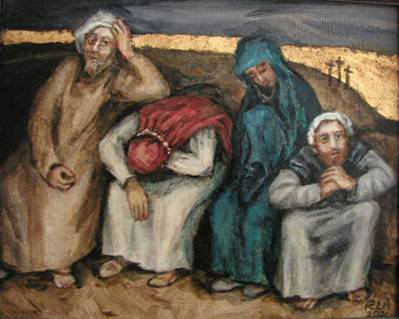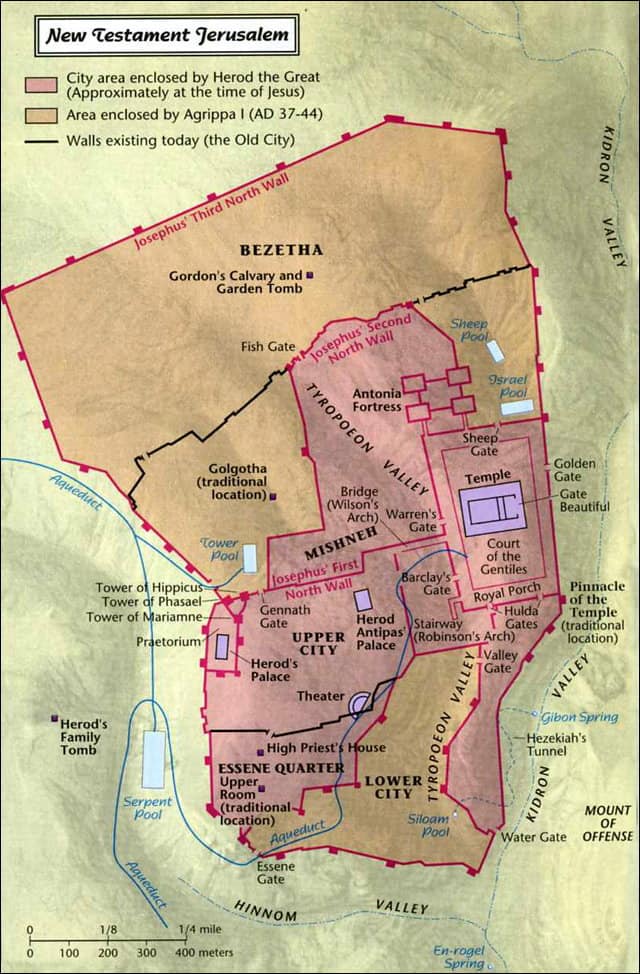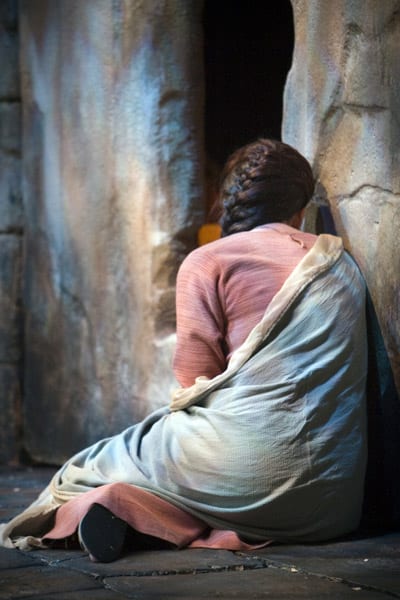Jesus was taken down from the cross a few hours before sundown on the preparation day for Passover, the afternoon of the 14th of Nisan. Joseph of Arimathea, an influential follower, had hastily placed Jesus’ dead body in an unfinished rock-hewn tomb that just happened to be near the place of execution until after the festival and the Sabbath day when proper rites of Jewish burial could be carried out and decisions about a permanent burial place could be made. A blocking stone had been placed at the entrance to protect against predators.
Just after sundown the entire Jewish populace of Jerusalem, swollen by tens of thousands of pilgrims, gathered to eat the Passover meal. Jesus’ core followers, including the twelve apostles, and a band of disciples, both men and women, who hopefully followed him down to the festival from Galilee expecting him to publicly reveal himself as Messiah were in utter despair. Their Teacher was dead–brutally murdered by his Roman and Jewish enemies in the most shameful of deaths.

Jesus’ followers had scattered at his arrest the night before and we are not told where or how they observed Passover that night. One might assume they would have regathered at the house of Lazarus, in Bethany, just over the southern summit of the Mount of Olives, with the sisters Mary and Martha hosting the Passover meal for these out of town guests. Present would have been Mary Magdalene and Jesus’ mother, broken hearted beyond expression, as well as other close followers along with the Twelve. According to Mark, when Jesus and his band had arrived in Jerusalem a week earlier they had made this household their home, spending the nights there and their days in the Temple and its surrounding areas. As Jews they surely would have surely sat down together at the traditional Passover meal. One can scarcely imagine their grief and shock. Passover is normally a festival of joy and celebration but this particular “night to be much remembered,” to use Moses’s words, had to be the saddest of their lives. Our gospels record nothing of that evening or of the Passover day and Sabbath following. We must assume there was little to be said. A dead Messiah is no Messiah and all the talk about the kingdom of God being at hand, and the leaders sitting on thrones ruling over the regathered tribes of Israel had become meaningless.
The four New Testament gospels variously report what happened next. They do not agree on any of the substantive details and I have carefully documented their differences and the unfolding legendary embellishment of what happened that first Easter morning in several posts:
What Really Happened Easter Morning
The Strange Original Ending of the Gospel of Mark
We do have another ancient source that appears to change the entire story significantly–namely the Gospel of Peter, see “The Surprising Ending of the Lost Gospel of Peter.” This fragmentary narrative, discovered at the end of the 19th century, was found buried with a Christian monk in upper Egypt, just north of Nag Hammadi where another trove of ancient writings was found–including the Gospel of Thomas. It was our first non-canonical gospel to have surfaced for modern eyes. In more recent times two additional fragments were recovered that appear to belong with what we already had. This Gospel is narrated in the first person by Peter. Toward the end we find his strikingly significant words, and then the text breaks off:
[58] Now it was the final day of the Unleavened Bread; and many went out returning to their home since the feast was over. [59] But we twelve disciples of the Lord were weeping and sorrowful; and each one, sorrowful because of what had come to pass, departed to his home. [60] But I, Simon Peter, and my brother Andrew, having taken our nets, went off to the sea. And there was with us Levi of Alphaeus whom the Lord …
Notice–according to this source the disciples of Jesus spend the entire week of Passover and the seven days of Unleavened Bread–in a state of weeping and mourning. Clearly, in this tradition, no one has seen the multiple apparitions of Jesus reported by Matthew, Luke, and John. In fact, the Gospel of Peter agrees with our earliest gospel source–Mark. It has no appearances of Jesus but predicts a recovery of faith in Galilee. This is precisely what is implied in the appendix to the Gospel of John–chapter 21–which should be taken as a source separate from that gospel as a whole. Peter and the rest of the disciples depart home to Galilee, still in a state of mourning, and they resume their fishing business. That means the entire Easter morning cluster of stories of appearances in Jerusalem are late, legendary, and without any basis in history. As dear and central to Christian tradition as the Eastern morning “appearance” scenes might be, this alternative scenario, preserved in Mark, the Gospel of Peter, the appendix of John, and alluded to in the ending of Matthew, turns out to be more historically believable, and in the end more inspiring.

These sources ring true to what most likely happened and they give us a limited glimpse into Passover and the entire week following with all its sadness and disappointment. Christians today celebrate Easter but it seems clear that such was not the case that fateful Passover week in 30 CE. No one was rejoicing that weekend or through the next seven days. The return to Galilee must have been a painful one, leaving behind the body of their Teacher, now buried permanently in a tomb by Joseph of Arimathea. How the group recovered its faith that Jesus had indeed been exalted to the right hand of God is another story–but it took place clearly in Galilee not in Jerusalem, apparently during the 50 days between Passover and Shavuot or Pentecost–when the group would have returned to Jerusalem for the that pilgrim festival. It clearly had nothing to do with “bodily” appearances of Jesus, with Jesus limping up to Galilee sometime after the festival with festering wounds and crippled limbs. Jesus lifeless body was given back to the dust, like putting off old clothes, but faith that his spirit had returned to God and been “reclothed” with a new immortal spiritual body was the earliest resurrection faith. Here Paul is our best source as I have discussed extensively out in a previous post, “Why People are Confused about the Earliest Christian View of the Resurrection of the Resurrection of the Dead.”









Comments are closed.